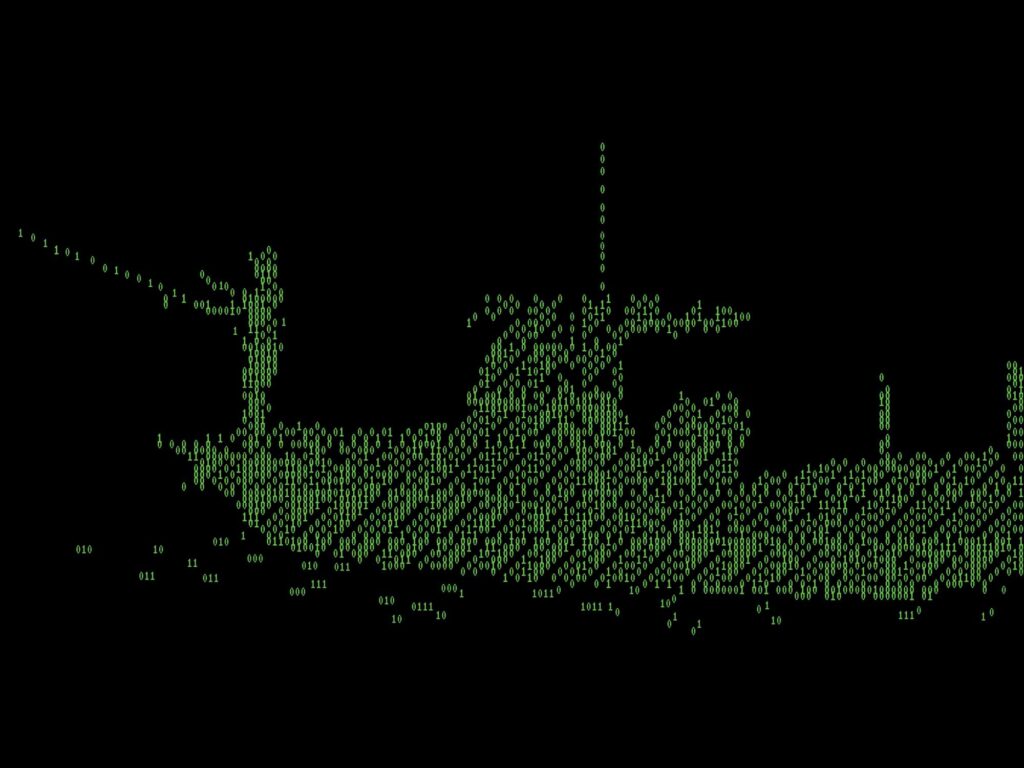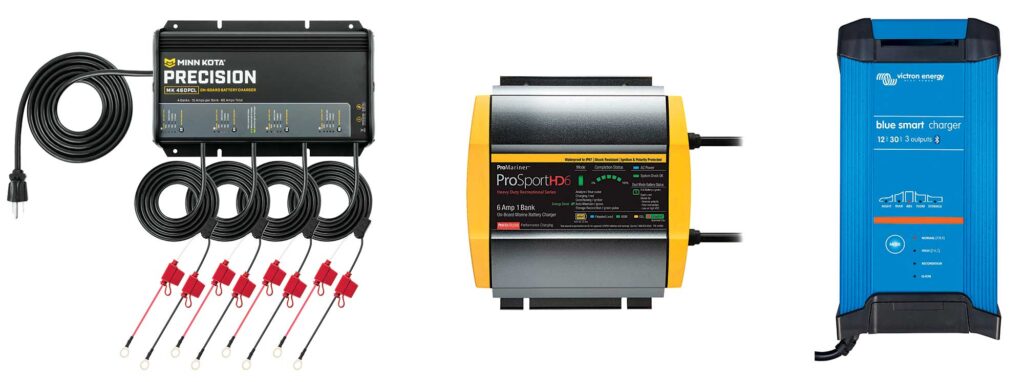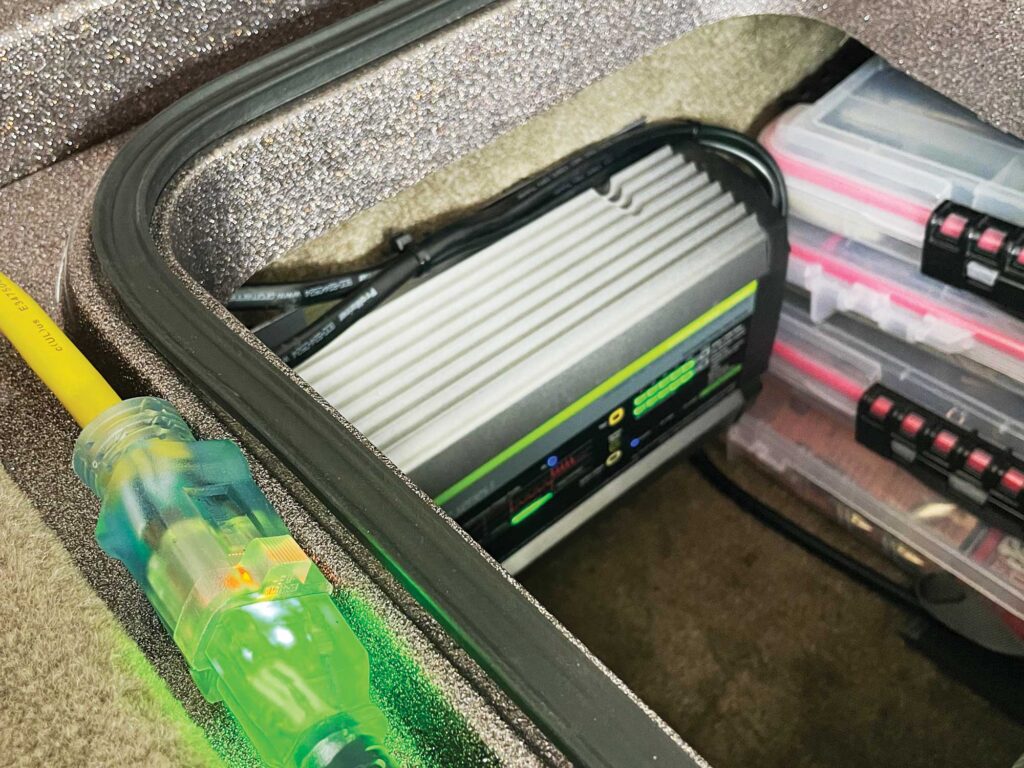SB Television
Choosing the Right Marine Battery Charger
 With increasing demands for onboard electrical power, marine AC battery chargers have become required equipment for today’s saltwater fishing boats.
Melvin Galapon/Debut Art
With increasing demands for onboard electrical power, marine AC battery chargers have become required equipment for today’s saltwater fishing boats.
Melvin Galapon/Debut Art
High-capacity marine battery banks have grown increasingly critical aboard today’s saltwater fishing boats in order to power the growing number of demanding onboard electrical systems. Equally important are marine AC chargers to replenish and maintain those DC battery banks between trips. Marine engine alternators often fall short in recharging batteries while fishing, and that’s why an AC charger ranks as a must-have item on your boat.
Brands such as Dakota, Guest, Minn Kota, Noco, ProMariner, Victron and others offer a host of marine chargers, many of them with advanced features and conveniences that make charging easier on you and the batteries.
Chargers are also shrinking in size and increasing in efficiency, says Craig Shaffer, director of product development for ProMariner.
“New electronic and digital technologies are allowing us to build lighter and smaller marine chargers while also boosting the efficiency levels to reduce the consumption of AC power during the charging process,” Shaffer explains.
For the purposes of this story, let’s focus on onboard chargers versus portable models with “alligator clips” for the battery terminals.
For most saltwater fishing boats, permanently installed onboard units that you plug into a shore-power or household outlet with an extension cord represent the best choice. Here, then, is the latest in what to look for in marine battery chargers.
WaterproofingMake sure the battery charger for your saltwater fishing boat is as water-resistant as possible to help prevent moisture damage, short circuits, corrosion and failure. ProMariner’s ProTournament Elite marine 12-volt chargers, for example, feature an IP67 sealed waterproof design that protects the unit from submersion in 3 feet of water for up to 30 minutes. Noco’s Genius Gen 12-volt marine chargers boast an IP68 rating, which protects from water submersion indefinitely in depths as great as 13 feet.
Battery-FriendlyToday’s best marine chargers feature multistage technology that brings the batteries up to full power as quickly as possible without the ill effects of overcharging, a frightful characteristic experienced with battery chargers of yesteryear. The Guest ChargePro series, for instance, uses a fully automatic five-stage sequence that senses, analyzes and briefly pre-charges batteries that have fallen below the 10-volt threshold. Then it bulk-charges and conditions the battery. It concludes with an energy-saver/maintenance mode that allows boaters to keep the charger plugged into AC power without the risk of overcharging or damaging the battery.
Selectable ProfilesToday’s marine batteries come in a range of technologies, including traditional flooded-cell and AGM lead-acid varieties, as well as the newer lithium-iron-phosphate (LiFePO4) models. Each type of battery chemistry needs different voltage set points in the multistage charging sequence. This is known as the charging profile. Many chargers let you match the charging profile to the battery type.
Take, for example, the Noco Genius charger that lets you change the profile with a press of a button to suit a flooded-cell, AGM or LiFePO4 battery. With Noco’s multibank chargers, you can designate each DC charging lead for a different type of battery, eliminating the need to buy separate chargers for flooded-cell, AGM and LiFePO4 batteries.
Voltage DeliveryNot all marine batteries are 12 volts. This is especially true with the growing number of LiFePO4 batteries, which include 24-, 36- and even 48-volt models. These higher-voltage batteries are used largely to power bow-mount electric trolling motors. Fortunately, chargers are keeping pace with the new technology. Dakota Lithium, for instance, offers models designed specifically to charge 24-, 36- and 48-volt LiFePO4 batteries used to power trolling motors.
Rate of ChargeThe speed of battery replenishment is measured in amps—the higher the amps, the faster the speed. But how do you decide how many amps are needed for your system? Generally speaking, group 24 and 27 batteries require a minimum of 5 amps per battery, while group 30 and 31 batteries need a minimum of 6 to 8 amps, says ProMariner’s Shaffer.
“If you’re a professional angler or a captain that needs to make sure the batteries are fully charged as quickly as possible, the charging amps should equal at least 10 percent of the battery’s amp-hour rating,” Shaffer adds. “Based on this formula, a 100-amp-hour battery requires a charger that delivers at least 10 amps for each battery.”
 Marine AC-to-DC chargers, such as the Minn Kota Precision four-bank and Victron Blue Smart three-bank, are available for multiple batteries, as are single-bank chargers like the ProMariner ProSport HD6.
Courtesy Minn Kota, ProMariner, Victron Energy
Number of Batteries
Marine AC-to-DC chargers, such as the Minn Kota Precision four-bank and Victron Blue Smart three-bank, are available for multiple batteries, as are single-bank chargers like the ProMariner ProSport HD6.
Courtesy Minn Kota, ProMariner, Victron Energy
Number of Batteries
Saltwater fishing boats often have multiple batteries, usually one starting battery per engine, two or more for the house-battery bank, and three to four for the trolling motor. This is where multibank marine chargers come into play, providing charging leads (each comprised of DC positive and negative wires) for each battery on your boat.
Boats with a lot of battery banks might need more than one charger. A common example is to have a four-bank charger that can simultaneously replenish two starting batteries and a pair of house batteries, plus a second three-bank charger serving three deep-cycle batteries for a 36-volt trolling motor.
ProMariner multibank chargers also feature distribute-on-demand technology that automatically senses and delivers greater charging amps through the leads to the battery or batteries that are lowest in juice versus others that might not need as much of a charge.
Read Next: The Advantages of Marine Lithium Batteries
 ProMariner’s ProTournament Elite chargers feature charge-indicator LEDs in the AC plug (foreground) as well as on the unit.
Courtesy ProMariner
Charge Monitoring
ProMariner’s ProTournament Elite chargers feature charge-indicator LEDs in the AC plug (foreground) as well as on the unit.
Courtesy ProMariner
Charge Monitoring
Marine battery chargers possess various means of conveniently monitoring the recharging process. One of the most common is a series of LED lights on the housing of the charger. The ProMariner ProSport series, for example, features three LEDs, one each to indicate whether it is charging (red), conditioning (orange), or fully charged and auto maintaining (green). There’s also a blue LED to indicate that the unit is plugged into AC power. With this system, having the charger mounted in an easy-to-access compartment allows you to keep an eye on the charging process.
However, the ProMariner ProTournament Elite series offers another monitoring system—an LED charge—status indicator housed in the AC plug that illuminates in three individual colors for charging (red), conditioning (orange) or auto maintaining (green) when connected to an extension cord outside of your boat. “This eliminates the need to remove the boat cover, climb in the boat or open a hatch to check the charge status,” Shaffer points out. “You just look at the AC plug to find out.”
Wireless TechnologySome marine chargers provide yet another means of monitoring the recharging process. For example, Victron’s Blue Smart IP67 battery charger is Bluetooth-enabled, allowing you to monitor charging voltage and current with the Victron app on a mobile device.
With increasing demands for onboard electrical power, marine AC battery chargers have become required equipment on today’s saltwater fishing boats. Thanks to advancements in charging technology, it’s easier than ever to keep marine battery systems in prime condition and ready to go fishing at a moment’s notice.
The post Choosing the Right Marine Battery Charger appeared first on Salt Water Sportsman.
- Home
- About Us
- Write For Us / Submit Content
- Advertising And Affiliates
- Feeds And Syndication
- Contact Us
- Login
- Privacy
All Rights Reserved. Copyright , Central Coast Communications, Inc.